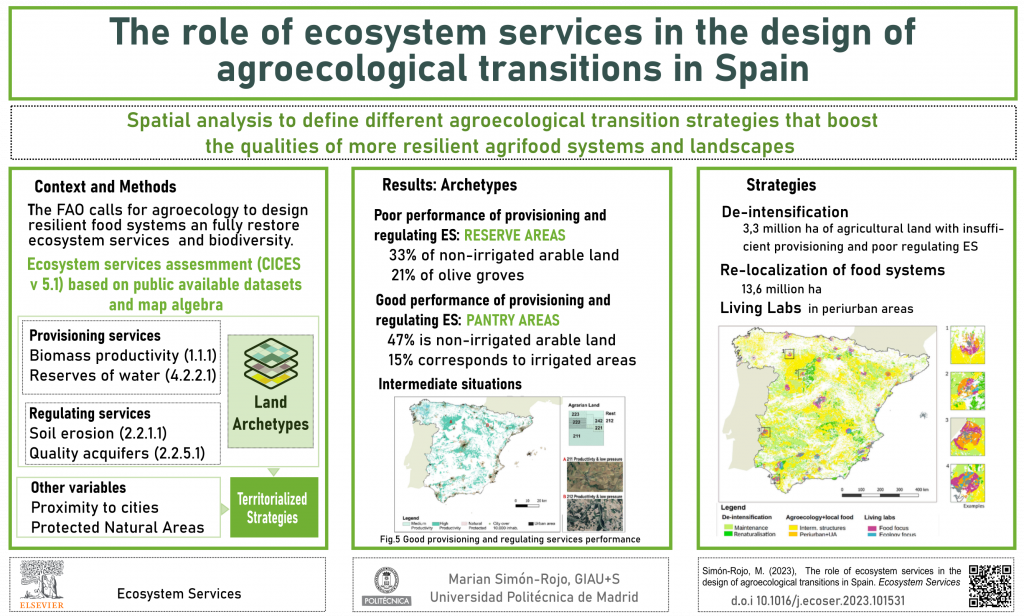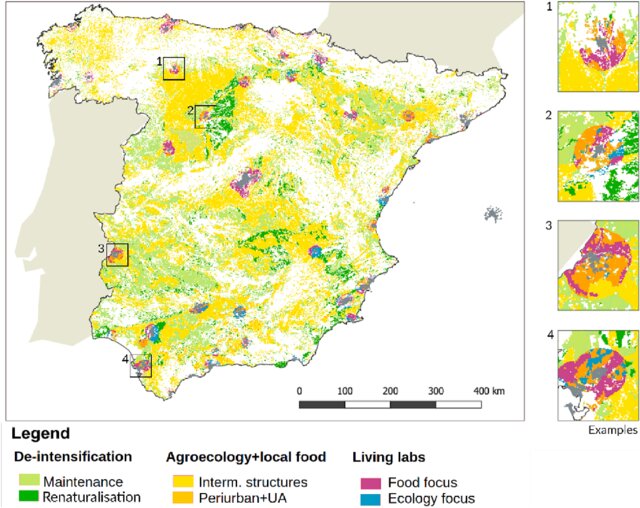Vamos tarde, puede que demasiado tarde para acomodarnos a los límites planetarios y garantizar unas condiciones de vida digna para todo el mundo. Pensando en cómo puede contribuir la ordenación del territorio a la necesaria transición que supere el modelo extractivista, surgió la investigación que se presenta en el artículo:
The role of ecosystem services in the design of agroecological transitions in Spain

La agroecología incorpora los principios ecológicos en el diseño y manejo de los agrosistemas, se adapta a los recursos locales, cierra los ciclos de la biomasa y los nutrientes y potencia la actividad biológica del suelo, así como su conservación y regeneración. Todo ello acompañado de relaciones justas. Si se quiere impulsar una transición agroecológica ¿hay territorios que reúnen mejores condiciones para ello?
Es un paso más en la línea que iniciamos hace prácticamente una década sobre integración de los SSEE en el planeamiento (PAEC-Sp). Utilizando bases de datos de acceso libre se ha realizado un análisis espacial de criterios utilizando MapAlgebra en QGIS, aplicando la Clasificación Internacional Común de los Servicios de los Ecosistemas, cuya versión 5.1 (CICES 5.1). Esta vez, exploramos la conceptualización de arquetipos para identificar qué zonas cumplen mejor con una transición agroecológica que conlleva el reequilibrio de los servicios ecosistémicos de aprovisionamiento, regulación y cultura. Nos ha permitido evaluar la mejora de los servicios ecosistémicos en España guiados por una planificación regional que sea plenamente consciente de la cadena alimentaria y garantice una gestión de los recursos respetuosa con los procesos ecológicos.
¿Dónde nos lleva incorporar los servicios de los ecosistemas en la ordenación del territorio con objetivos de transición agroecológica?
Podemos perseguir un futuro más resiliente y sostenible si tanto la agricultura como el sistema alimentario evolucionan impulsados por un nuevo modelo basado en la agroecología. Planteamos tres estrategias principales:
- Priorizar las políticas de desintensificación agrícola en áreas con un pobre desempeño de los servicios ecosistémicos tanto en lo que se refiere a la provisión de alimentos (baja producción) como a un impacto negativo en los servicios de regulación (sobreexplotación de acuíferos, contaminación, erosión de suelos). Abarca 3,3 millones de ha
- Proporcionar apoyo público para una transición agroecológica entrelazada con la relocalización de los sistemas alimentarios en áreas periurbanas y rurales bien adaptadas en cuanto a los servicios ecosistémicos de provisión de alimentación. La estrategia se orienta además a reforzar sus funciones relativas a la retención del suelo y los servicios de regulación de la calidad de las aguas subterráneas (13,6 millones de ha);
- Promover zonas periurbanas con potencial como espacios de experiencia (Living Labs) agroecológicos o ecológicos, correspondiendo estos últimos a zonas no aptas para la producción de alimentos que se incorporan a procesos de regeneración de ecosistemas semi-naturales.

Referencias
Aguilera, E., Rivera Ferre, M.G., 2022. La urgencia de una transición agroecológica en España. Amigos de la Tierra.
Altieri, M.A., Koohafkan, P., Holt, G.E., 2012. Agricultura verde: fundamentos agroecológicos para diseñar sistemas agrícolas biodiversos, resilientes y productivos. Agroecología 7 (1), 7–18.
Altieri, M.A., Nicholls, C.I., Henao, A., Lana, M.A., 2015. Agroecology and the design of climate change-resilient farming systems. Agron. Sustain. Dev. 35 (3), 869–890.
Birkhofer, K., Bezemer, T.M., Bloem, J., Bonkowski, M., Christensen, S., Dubois, D., Mäder, P., 2008. Long-term organic farming fosters below and aboveground biota: Implications for soil quality, biological control and productivity. Soil Biol. Biochem. 40 (9), 2297–2308.
Bisselink, B., Bernhard, J., Gelati, E., Adamovic, M., Guenther, S., Mentaschi, L. and De Roo, A., 2018. Impact of a changing climate, land use, and water usage on Europe’s water resources, EUR 29130 EN, Publications Office of the European Union, Luxembourg. ISBN 978-92-79-80287-4, doi: 10.2760/847068, JRC110927.
Borron, S., 2006. Building Resilience For An Unpredictable Future: How Organic Agriculture Can Help Farmers Adapt To Climate Change. Food and Agriculture Organization of the United Nations, Rome.
Brussaard, L., De Ruiter, P.C., Brown, G.G., 2007. Soil biodiversity for agricultural sustainability. Agr. Ecosyst. Environ. 121 (3), 233–244.
Busby, G., Rendle, S., 2000. The transition from tourism on farms to farm tourism. Tour. Manag. 21 (6), 635–642.
Cabell, J.F., Oelofse, M., 2012. An indicator framework for assessing agroecosystem resilience. Ecol. Soc. 17 (1), 18. https://doi.org/10.5751/ES-04666-170118.
De Leijster, V., Santos, M.J., Wassen, M.J., Ramos-Font, M.E., Robles, A.B., Díaz, M., Verweij, P.A., 2019. Agroecological management improves ecosystem services in almond orchards within one year. Ecosyst. Serv. 38, 100948.
de Zeeuw, H., Drechsel, P., (Eds.), 2015. Cities and agriculture: Developing resilient urban food systems. Routledge.
Erel, R., Yermiyhu, Y., Ben-Gal, A., Dag, A. 2017. Olive fertilization under intensive cultivation management. In VIII International Symposium on Mineral Nutrition of Fruit Crops 1217 (pp. 207-224).
European Commission. 2019. The European Green Deal. Communication from the Commission.https://ec.europa.eu/info/sites/info/files/european-green-dealcommunication_
en.pdf.
European Environment Agency. 2018. The circular economy and the bioeconomy. Partners in sustainability. Report No 8/2018.
Francis, C., Lieblein, G., Gliessman, S., Breland, T.A., Creamer, N., Harwood, R., Wiedenhoeft, M., 2003. Agroecology: The ecology of food systems. J. Sustain. Agric. 22 (3), 99–118.
Fresco, L.O., Poppe, K.J., 2016. Towards a Common Agricultural and Food Policy. Wageningen University and Research.
Gliessman, S., 2016. Transforming food systems with agroecology. Agroecol. Sustain. Food Syst. 40 (3), 187–189. https://doi.org/10.1080/21683565.2015.1130765.
Gliessman, S., Friedmann, H., H Howard, P. (2019). Agroecology and food sovereignty.
Gomiero, T., Pimentel, D., Paoletti, M.G., 2011. Environmental impact of different agricultural management practices: conventional vs. organic agriculture. Crit. Rev. Plant Sci. 30 (1–2), 95–124.
Gonzalez de Molina, M., Toledo, V., 2014. The social metabolism: a socio-ecological theory of historical change (Vol. 3). Springer.
Haines-Young, R., Potschin-Young, M., 2018. Revision of the common international classification for ecosystem services (CICES V5. 1): a policy brief. One Ecosystem 3, e27108.
Hart, K., Baldock, D., 2011. Greening the CAP: Delivering environmental outcomes through pillar one. Institute for European Environmental Policy, 26.
Infante Amate, J., Gonzalez de Molina, M., Vanwalleghem, T., Fernandez, D.S. and Gomez, J.A., 2013. Erosion in the Mediterranean: The case of olive groves in the south of Spain (1752–2000). Environmental History.
IPES-Food. 2019. Towards a Common Food Policy for the European Union – IPES food.
Jax, K., Furman, E., Saarikoski, H., Barton, D.N., Delbaere, B., Dick, J., Maes, J., 2018. Handling a messy world: Lessons learned when trying to make the ecosystem services concept operational. Ecosyst. Serv. 29, 415–427.
La Notte, A., D’Amato, D., M¨akinen, H., Paracchini, M.L., Liquete, C., Egoh, B., Geneletti, D., Crossman, N.D., 2017. Ecosystem services classification: A systems ecology perspective of the cascade framework. Ecol. Ind. 74, 392–402.
Lopez-García, D., Gonzalez de Molina, M., 2021. An operational approach to agroecology-based local agri-food systems. Sustainability 13 (15), 8443.
MAPA (2022). Plan Estrategico de la PAC de España.
Marshall, E.J.P., Moonen, A.C., 2002. Field margins in northern Europe: their functions and interactions with agriculture. Agr. Ecosyst. Environ. 89 (1–2), 5–21.
McHarg, I.L., 1969. Design with Nature. American Museum of Natural History, New York, p. 197.
Mockshell, J., Kamanda, J., 2018. Beyond the agroecological and sustainable agricultural intensification debate: Is blended sustainability the way forward? Int. J. Agric. Sustain. 16 (2), 127–149.
Moragues-Faus, A., Morgan, K., 2015. Reframing the foodscape: the emergent world of urban food policy. Environment and Planning A: Economy and Space 47 (7), 1558–1573.
Naredo, J. M., Gonzalez de Molina Navarro, M. 1996. Evoluci´on de la agricultura en España, 1940-1990. Universidad de Granada.
Nicholls, C.I., Altieri, M.A., Vazquez, L., 2016. Agroecology: principles for the conversion and redesign of farming systems. J. Ecosys. Ecograph. S. 5, 010.
Palomo-Campesino, S., Gonzaalez, J.A., García-Llorente, M., 2018. Exploring the connections between agroecological practices and ecosystem services: a systematic literature review. Sustainability 10, 4339.
Pérez-Soba, M., Elbersen, B., Kempen, M., Braat, L., Staristky, I., Wijngaart, R. V., REGA, C., 2015. Agricultural biomass as provisioning ecosystem service: quantification of energy flows. EUR27538 En. doi, 10, 679096.
Perfecto, I., Vandermeer, J., Wright, A., 2009. Nature’s Matrix: Linking Agriculture, Conservation and Food Sovereignty. Routledge.
Pinto-Correia, T., Primdahl, J., Pedroli, B., Pedroli, G.B.M., 2018. European Landscapes in Transition. Cambridge University Press.
Pörtner, H.O., Roberts, D.C., Adams, H., Adler, C., Aldunce, P., Ali, E., Ibrahim, Z.Z.,Climate Change 2022: Impacts, Adaptation and Vulnerability. IPCC, Geneva,Switzerland, p. 3056.
Rodríguez-Ortega, T., Olaizola, A.M., Bernu´es, A., 2018. A novel management-based system of payments for ecosystem services for targeted agri-environmental policy. Ecosyst. Serv. 34, 74–84.
Rusco, E., Jones, R. J., Bidoglio, G., 2001. Organic matter in the soils of Europe: Present 810 status and future trends (p. 14). Institute for Environment and Sustainability, Joint Research 811 Centre, European Commission.
Sage, C., 2014. The transition movement and food sovereignty: from local resilience to global engagement in food system transformation. J. Consum. Cult. 14 (2), 254–275.
Schröter, B., Matzdorf, B., Sattler, C., Alarcon, G.G., 2015. Intermediaries to foster the implementation of innovative land management practice for ecosystem service provision–a new role for researchers. Ecosyst. Serv. 16, 192–200.
Siegrist, S., Schaub, D., Pfiffner, L., Mäder, P., 1998. Does organic agriculture reduce soil erodibility? The results of a long-term field study on loess in Switzerland. Agr. Ecosyst. Environ. 69 (3), 253–264.
Simon-Rojo, M., Recasen, X., Callau, S., Duzi, B., Eiter, S., Hernandez-Jimenez, V., Scazzosi, L., 2016. From urban food gardening to urban farming. In: Lohrberg, F.,Liˇcka, L., Scazzosi, L., Timpe, A. (Eds.), Urban Agriculture Europe. Jovis.
Simon-Rojo, M., Couceiro-Arroyo, A., Fari˜na-Tojo, J., 2019. La relocalizacion alimentaria debil: desconexi´on entre agentes del territorio y planificacion espacial Urbano 106–123.
Simon-Rojo, M. 2016. El territorio en el sistema agroalimentario: el tramo medio del valle del Duero 1900-2015 (Doctoral dissertation, Universidad Politecnica de Madrid).
Smith, L.G., Williams, A.G., Pearce, B.D., 2015. The energy efficiency of organic agriculture: a review. Renewable Agric. Food Syst 30 (3), 280–301.
Soule, J., Piper, J., 1992. Farming in Nat’re’s Image: An Ecological Approach to Agriculture. Island Press.
Tornaghi, C., 2017. Urban agriculture in the food-disabling city:(re) defining urban food justice, reimagining a politics of empowerment. Antipode 49 (3), 781–801.
Toth, G., Gardi, C., B´odis, K., Ivits, ´E., Aksoy, E., Jones, A., Jeffrey, S, Petursdottir, T., Montanarella, L. 2013. Continental-scale assessment of provisioning soil functions in Europe. Ecol. Processes 2:32; DOI: 10.1186/2192-1709-2-32.
UNEP, 2011. Towards a Green Economy: Pathways to Sustainable Development and Poverty Eradication. UNEP, Nairobi, Kenya.
Verburg, P.H., Koomen, E., Hilferink, M., P´erez-Soba, M., Lesschen, J.P., 2012. An assessment of the impact of climate adaptation measures to reduce flood risk on ecosystem services. Landsc. Ecol. 27 (4), 473–486.
Westhoek, H., Lesschen, J.P., Rood, T., Wagner, S., De Marco, A., Murphy-Bokern, D., Leip, A., van Grinsven, H., Sutton, M.A., Oenema, O., 2014. Food choices, health and environment: effects of cutting Europe’s meat and dairy intake. Glob. Environ. Chang. 26, 196–205.
